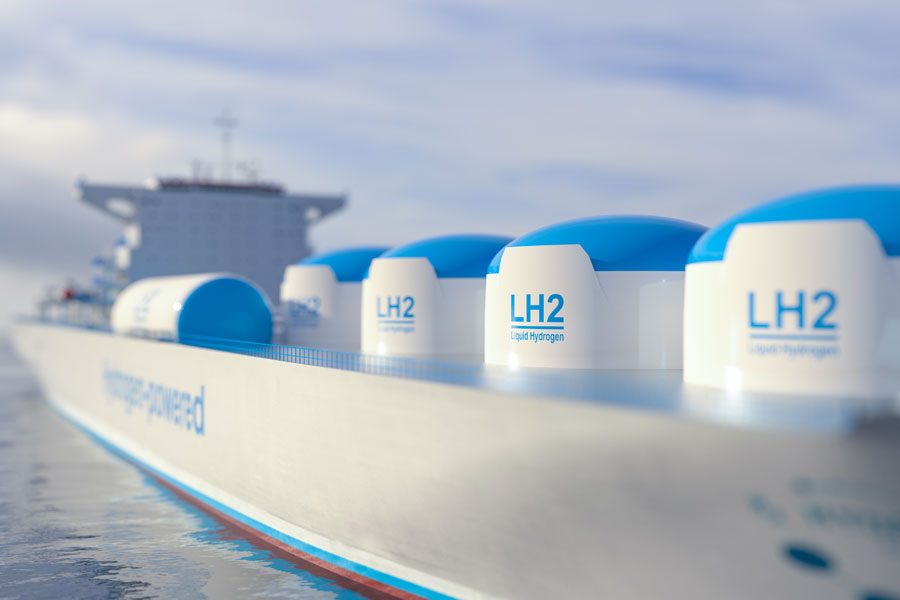Hydrogen A to Z Series: M For Marine Mobility
By: GenH2 Staff
Read Time: 4 minutes
Defining Hydrogen from A-Z: M is for Marine Mobility
Continuing in our Defining the Hydrogen Economy from A to Z series we are discussing the letter M, for Marine Mobility. Like other sectors of mobility, the maritime transport sector is facing the challenge of the low-carbon transition. The International Maritime Organization (IMO), the United Nations’ regulatory body for shipping, has called for a 50 percent reduction in greenhouse gas (GHG) emissions by 2050 in order to align the industry with the objectives of the Paris Climate Agreement. So, what are companies and organizations in maritime mobility doing to reach these goals?
Shipping Industry
According to the United States Environmental Protection Agency (EPA), maritime shipping accounts for approximately one-quarter of all emissions from the global transportation sector. Emitting nearly one billion tons of CO2 per year, the shipping industry is addressing decarbonization in the coming decades and using hydrogen as a stand-out option for alternative energy for marine mobility.
A Global Maritime Forum study from March 2021 examined 106 projects looking at zero emissions in maritime shipping worldwide and found that nearly half of these initiatives focused on hydrogen as an alternative choice. A key advantage of hydrogen over other fuel alternatives is the relative ease of retrofitting existing ships with hydrogen fuel cells. It is proposed, Hydrogen fuel could replace 43 percent of voyages between the United States and China without any changes, and 99 percent of voyages with minor changes to fuel capacity or operations.
While no giant shipping vessels have been tested with hydrogen yet, hydrogen-powered ferries and smaller shipping vessels have been piloted in the United States, Belgium, France and Norway. Oil major Royal Dutch Shell has also invested in several hydrogen production projects stating that hydrogen is “advantaged over other potential zero-emissions fuels for shipping.”
Cruise Industry
Let’s not forget recreational marine mobility and look at the innovations made by the cruise industry. Royal Caribbean Group’s ultra-luxury brand Silversea Cruises has announced plans to launch a hybrid-powered ship, which will include a hydrogen fuel cell in summer 2023. This ship is said to be the cruise industry’s first such vessel, with the hybrid solution enabling the ship to be local emissions-free while docked at ports.
The new class of vessels, named Project Evolution, will use a trio of power sources, including the fuel cell system, battery technology and dual-fuel engines, which will use liquefied natural gas (LNG) as the primary fuel. The hydrogen-based fuel cell system will contribute to the main power supply as well as carry the vessel’s total hotel load up to four megawatts. According to the company, this is the first large-scale fuel-cell installation at sea in the cruise sector.
Carnival Corporation-owned German cruise line announced its partnership with leaders from the maritime and engineering sectors to pilot the world’s first fuel cell system designed to power large passenger vessels. Meanwhile, Fincantieri recently announced that it is joining with a couple of its customers, to explore the potential for the world’s first hydrogen-powered cruise ship. During the next 12 months, the partnership will study key factors related to the development of ocean-going hydrogen-powered cruise ships. This includes arranging ship spaces to accommodate H2 technologies and fuel cells, technical parameters of onboard systems, calculating the potential greenhouse gas emissions savings, and a technical and economic analysis of hydrogen supply and infrastructure.
Hyundai Motor will develop a marine mobility platform powered by seawater by 2023 to replace small and mid-sized diesel ships. Through the project, Hyundai Motor is targeting the standardization of small and mid-sized hydrogen ships. According to industry sources, Hyundai is developing a 15-20 meter-long yacht powered by the firm’s hydrogen fuel cells. It is designed with equipment to break seawater into hydrogen, and the hydrogen fuel cells will use the extracted hydrogen to power propellers. Solar panels will be used to generate clean electricity to break seawater into hydrogen.
Conclusion
Reducing greenhouse gas (GHG) emissions by 50% in the maritime industry requires innovation, a substantial increase in hydrogen production and transfer/distribution, and the infrastructure to support it. This is why companies like GenH2 are addressing innovative hydrogen solutions from the mega to the micro scale for multiple markets, including the marine and shipping industries. Please join as next week as we revisit the alphabet L and Liquefaction.



